DAY FIVE: Trial Against David Castillo, Co-Author of Berta Cáceres' Murder
/Last update: April 29 at 8:48 pm
Main Points of the Day
Today, the trial consisted of the witness testimony from investigator Jesús Perdomo and a brief expert analysis by ballistic expert Olman García who studied the gun found in Henry Hernandez’s home [Hernandez was convicted in November 2018 of Berta’s murder] that matched fragments and bullets found during the autopsy and at the crime scene. In addition, several documents and the relevant physical evidence were ratified by state agents involving inspections of the crime scene; inspections of the convicted men’s houses raided by investigators, several cell phones that were seized; the firearm found in Hernandez’s home; and the bullets recovered from the autopsy and crime scene.
Investigative agent Jesús Perdomo testified that the first line of investigation into Berta Cáceres murder was based on a theory that it was a crime of passion. The second line of investigation involved an individual that lived in a neighborhood close to the scene of the murder. Then investigators began to consider lines of investigation related to DESA and threats that Berta had received, according to testimonies of COPINH members, for resisting the Agua Zarca dam.
COPINH published documents (see below) during the course of today’s proceedings questioning the role of Security Minister Julian Pacheco in promoting the first line of investigation mentioned by agent Jesús Pacheco; and documents related to the military careers of Douglas Bustillo and Mariano Díaz Chavez questioning whether high-level military officials also knew about and were part of the murder.
The proceedings ended at 9:35 pm and will begin again tomorrow at 10 am.
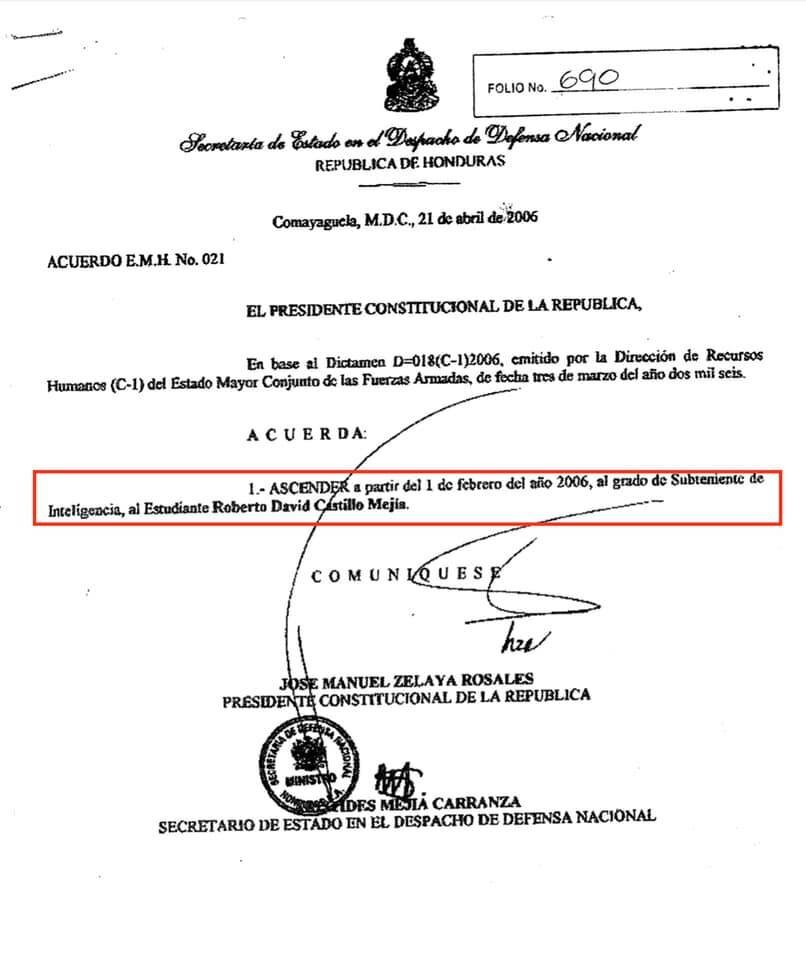
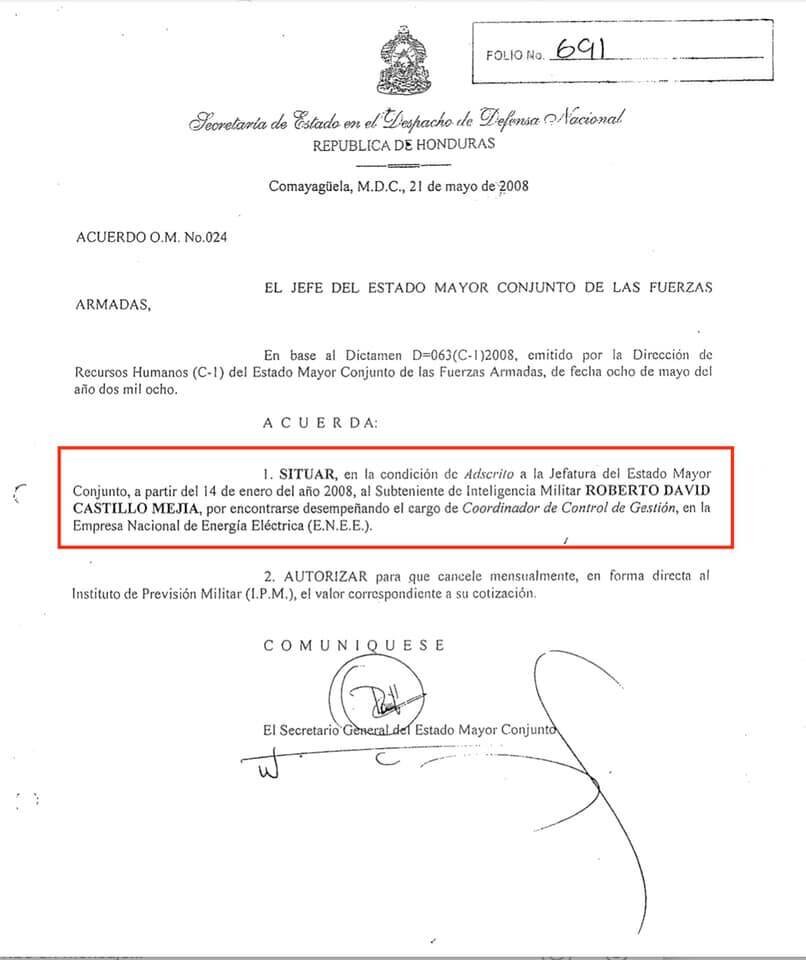

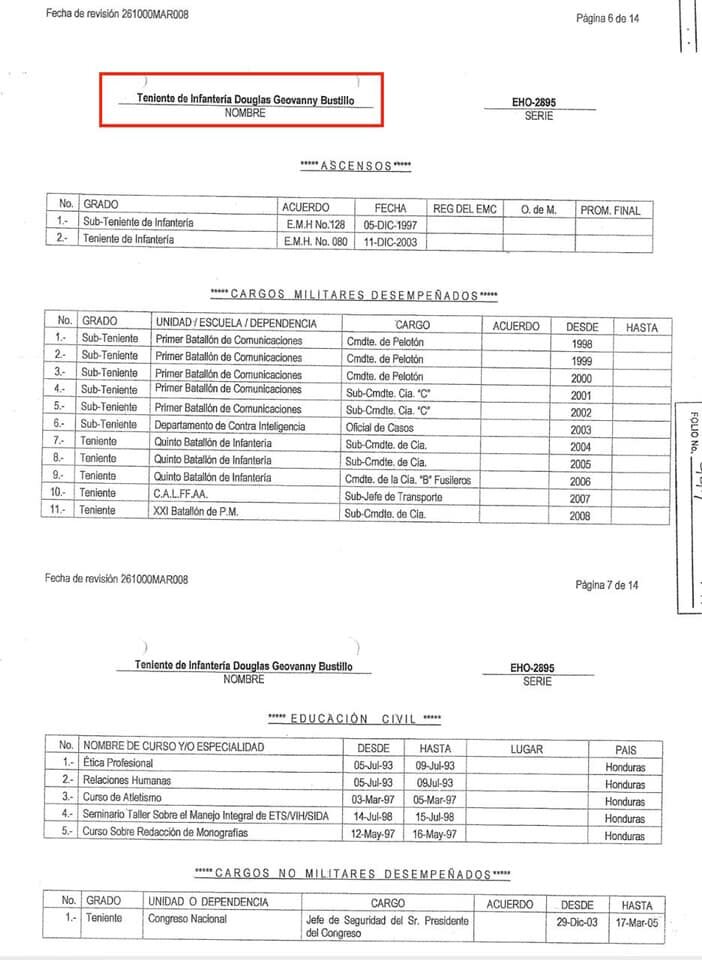
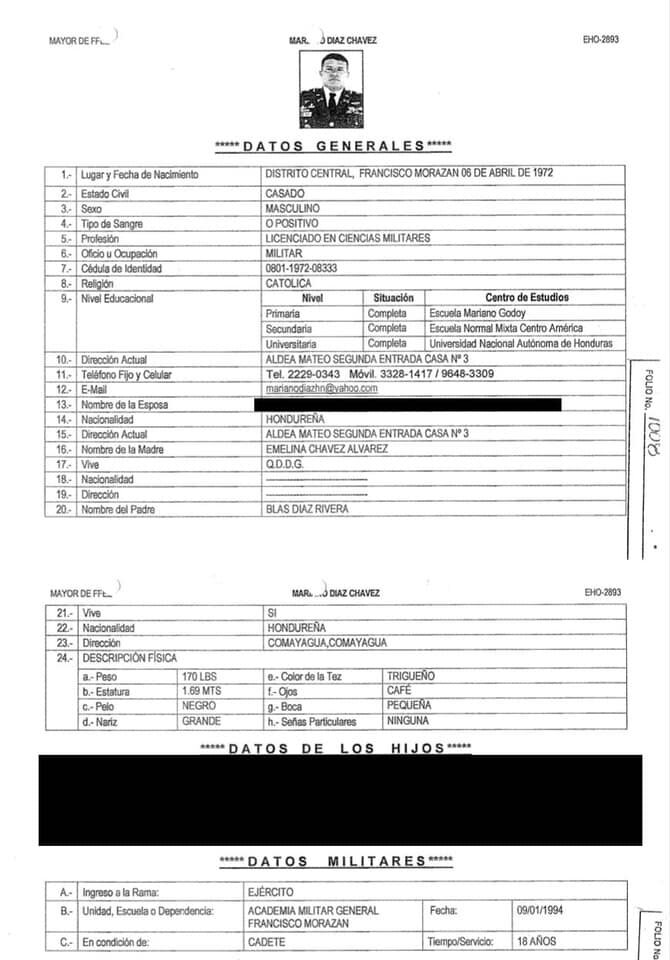
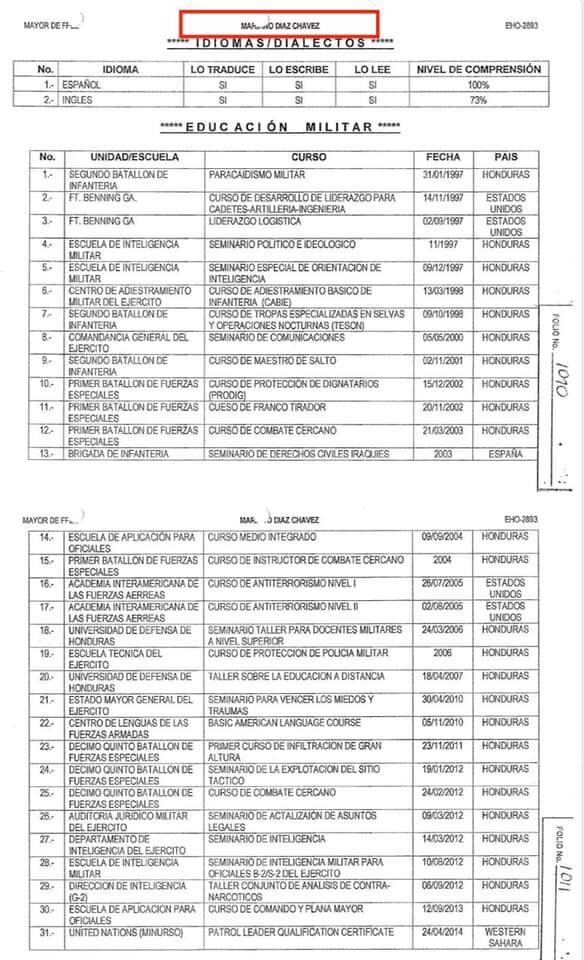
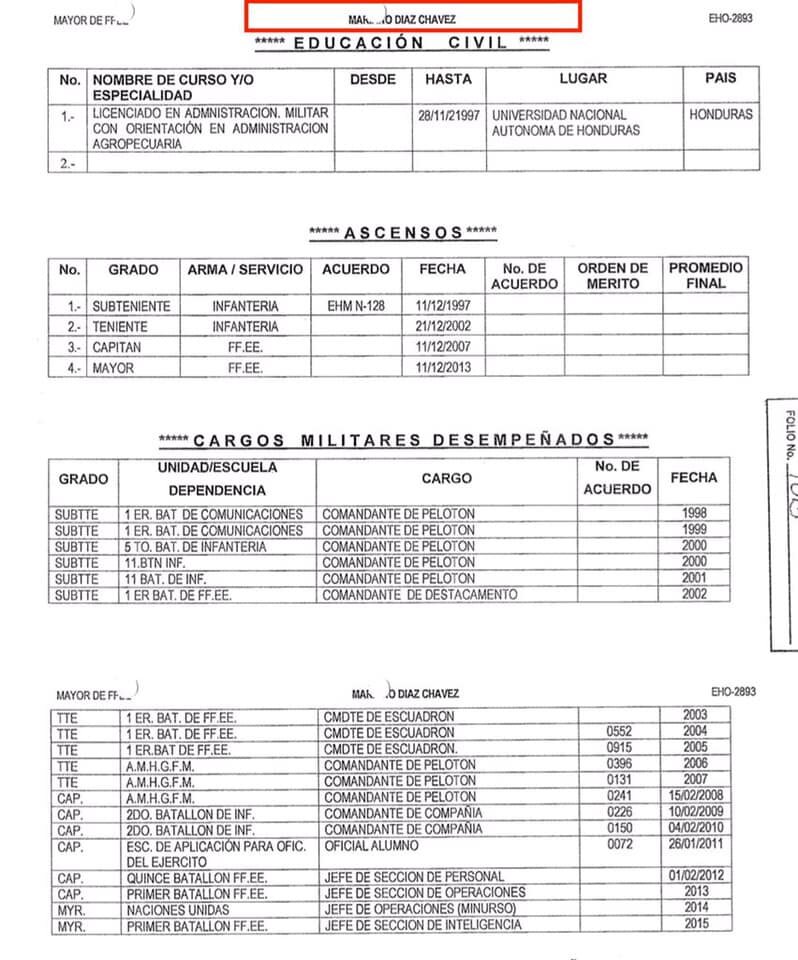
COPINH writes: “David Castillo used his military intelligence knowledge to monitor, harass, and intimidate Berta Cáceres. Castillo coordinated the operation to assassinate Berta with convicted Douglas Bustillo and Mariano Díaz. They are members of the Honduran Armed Forces that were trained in the United States. They used their military knowledge in a criminal manner. The authorities refuse to investigate the structures inside the military that were involved in these types of crimes. Mariano Díaz was an active military major and was a Military Police instructor when he was arrested. Why have the authorities not investigated any connections between high-level officials in the Armed Forces to the crime? See the attached documents.”
More Details
Testimony of Investigative Agent Jesús Perdomo
On March 3, 2016, I went with a multi-disciplinary investigative team to La Esperanza to initiate an investigation into Berta Cáceres’ murder. There was already a person that had been detained related to the first line of investigation which consisted of the theory that it was a crime of passion. Aureliano Molina had been detained because someone had testified that they had seen Molina in a vehicle close to Berta’s residence. Molina maintained that he was not responsible for the murder and he had not been near the house. We examined his phone records and took the testimony of a family member who said that Molina had received a call informing him that Berta had been murdered and traveled from his home to La Esperanza afterwords.
After reviewing the phone records, we determined that his telephone had been located in Lempira [where Molina lives] and according to the phone antennas, he had traveled to La Esperanza. We then took the testimonies of members of COPINH, family members, and it was established that Berta had been involved in a struggle against the Agua Zarca hydroelectric project.
The next line of investigation involved investigating an individual who had been arrested for killing a woman near the neighbourhood where Berta lived. We raided the individual’s house and found nothing that confirmed this line of investigation.
In the preliminary investigations of phone calls from the area of the crime scene, we found a telephone number that belonged to Douglas Bustillo. The case got more complex so more agents joined the investigation.
In our first report, we outlined the involvement of 5 people in the crime. We requested telephone records. We inspected a security camera located at the entrance of the El Líbano community [where Berta lived and the murder occurred]. From that security camera, we were able to identify a car that had been parked on the road close to the community the night of the murder.
Using phone data, we identified five phone numbers that we considered to be suspicious once other investigators had identified the phone numbers that had connected to the nearby phone towers. We identified these phones as belonging to Henry Hernandez, Edilson Duarte Meza, and another person named Dilma.
Tracing the movement of the cellphones, we could see that these individuals had traveled in the direction of El Líbano, and it was clear that there was communication between the suspects and the person that was driving the vehicle parked on the road.
When we identified Edilson Duarte Meza, we went to La Ceiba and through human sources, we located his residence. We carried out a search and found a weapon.
When the houses of Sergio Rodriguez and Mariano Díaz Chavez were raided, we collected their phones. We also raided DESA’s offices and seized cell phones found inside. In our report, we reported that Rodriguez and Bustillo, Chavez, Duarte, and Hernandez, had been identified as suspicious. Other agents got involved and later reported that Bustillo had communicated by telephone with the hitman.
We then went to the offices of the security company where Bustillo worked. We interviewed Bustillo’s boss and were able to confirm Bustillo’s telephone number.
The five telephone numbers mentioned previously, coincided with movements of the phones on the day of the murder. The data demonstrated that the cell phones had traveled from La Ceiba to La Esperanza.
We identified a protected witness that testified that Elvin Rapalo had admitted to her that he had participated in the murder. Using Rapalo’s Facebook page, we identified his phone number. The phone was in the name of a person named Vilma. We took her testimony and she told us that the phone had been stolen.
We then raided his home in San Pedro Zacapa in Santa Barbara. We then identified, through phone data, Henry Hernandez. Using social media, we located him in Mexico. We contacted the Mexican authorities who then deported him to Honduras and upon arrival, he was arrested.
During or after [unclear] his arrest, Hernandez explained how the crime had occurred and how the hitman had shot at the protected witness inside Berta’s home. He outlined several details about the night of the murder. We also identified another person, Oscar Torres, nickname “Coca” using social media.
The last report I presented, together with agents Elvin Maradiaga and Carolina Maldonado, we outlined the involvement of David Castillo in the murder. The document was based on official reports and data extractions that had been found in the raids. These included Whatsapp conversations between Bustillo and Castillo where they discussed logistics and other relevant incidents. According to the telephone company, the phone was used by David Castllo and we were able to interview others that confirmed this information. We also were able to confirm the telephone used by Bustillo by interviewing protected witness JAP-2018.
The prosecutor, private accusers and the defense all questioned the witness.
Jesús Perdomo was also asked to ratify a document pertaining to an investigation into the security company PCI Inc where both Bustillo and Hernandez worked. The document confirms the existence of an employment request that includes a phone number linked to the murder.
Testimony of Ballistic Expert Olman Garcia
The ballistic laboratory received a .38 calibre weapon and it was compared to the bullet casings and fragments found at the crime scene as well as two bullets recovered during the autopsy.
We first tested whether the weapon worked and then compared it to the evidence we received. We found that the weapon matched the type of bullets from the autopsy and the 3 bullets including one fragment that was found at the crime scene. We concluded that the weapon was operative and that it had fired the bullets found in the autopsy and the crime scene.
Each bullet, once fired, that includes the unique characteristics of the weapon it was fired from. We found these characteristics to match the weapon that was given to us to analyze.
The expert witness identified the physical bullets presented to him by court authorities as well as the Smith and Wesson gun that was found in Henry Hernandez’s home during a raid carried out by investigators.
Prosecutors asked questions. Both private accusers and the defense declined to question the expert witness.
Ratifying Documents Relevant to the Investigation
NOTE: Investigators that wrote, signed, or were responsible for specific documents pertinent to the investigation are called to ratify and answer brief questions about the document and the action described in the document. Below is a list of these documents. The questions asked, if any, are not included in the summary below as they don’t add much to understanding the content of the document. There were moments that the signal cut out and details were missed.
Technician Sandra Garcia Gladys ratified the document describing the physical inspection of Berta Cáceres’ house in the El Líbano residence in La Esperanza
Technician Ruth Elena Franco ratified the document describing the inspection and raid on the home of Emerson Duarte [convicted for Berta’s murder in November 2018]
Investigative agent Allan Aplicano Ramirez ratified the document describing the seizure of the LG phone belonging to Lesly Patricia Zambrano Zúniga (Douglas Bustillo’s spouse)
Jimmy Arturo Espinoza ratified the document describing the raid on Mariano Díaz Chavez’s home where three cell phones were found: One white Blu phone, a blue Samsung, and a black Sony.
Agent Saúl Colindres ratified the document describing the physical search conducted of David Castillo during his arrest and two cell phones were taken from him - two Iphones, one black and the other blue.
William Alvarado Guevara ratifies two documents: The personal search and seizure of a white Blu cell phone that was believed to belong to Henry Hernandez [convicted for Berta’s murder].
